CQUniversity ACCT20075: Audit Report for Regis Resources Limited
VerifiedAdded on 2022/10/04
|13
|2785
|23
Report
AI Summary
This report presents an audit analysis of Regis Resources Limited, a publicly listed gold operation company. The report begins by examining materiality and the scope of the audit, including the calculation of planning materiality. It then delves into analytical procedures applied to the company's financial statements, focusing on liquidity, profitability, and leverage ratios. The analysis includes a review of the company's cash flow statement, highlighting key inflows and outflows. Finally, the report assesses the auditor's report, including compliance with regulations and key audit matters. The report aims to provide a comprehensive overview of the auditing process and the company's financial performance.
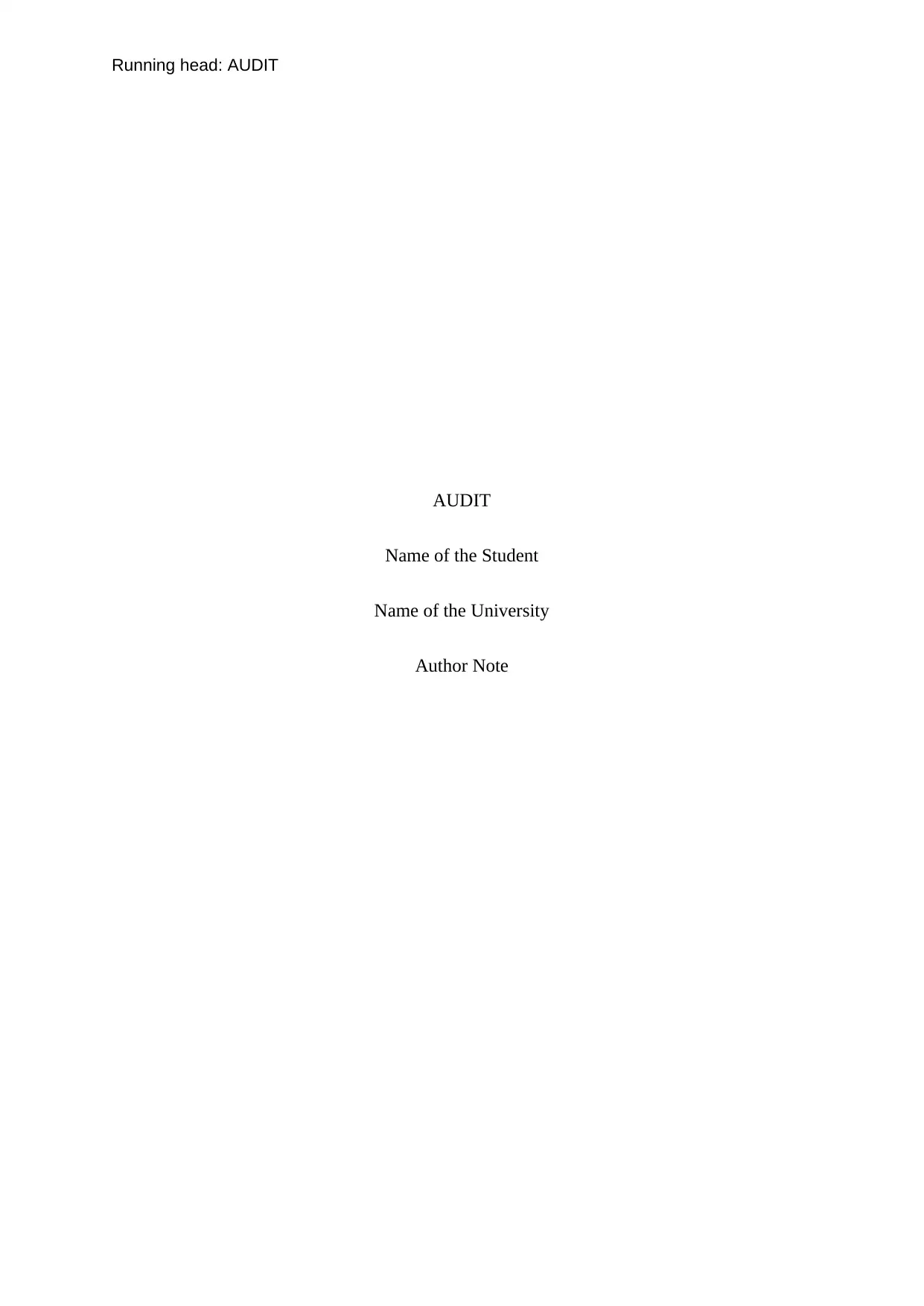
Running head: AUDIT
AUDIT
Name of the Student
Name of the University
Author Note
AUDIT
Name of the Student
Name of the University
Author Note
Paraphrase This Document
Need a fresh take? Get an instant paraphrase of this document with our AI Paraphraser
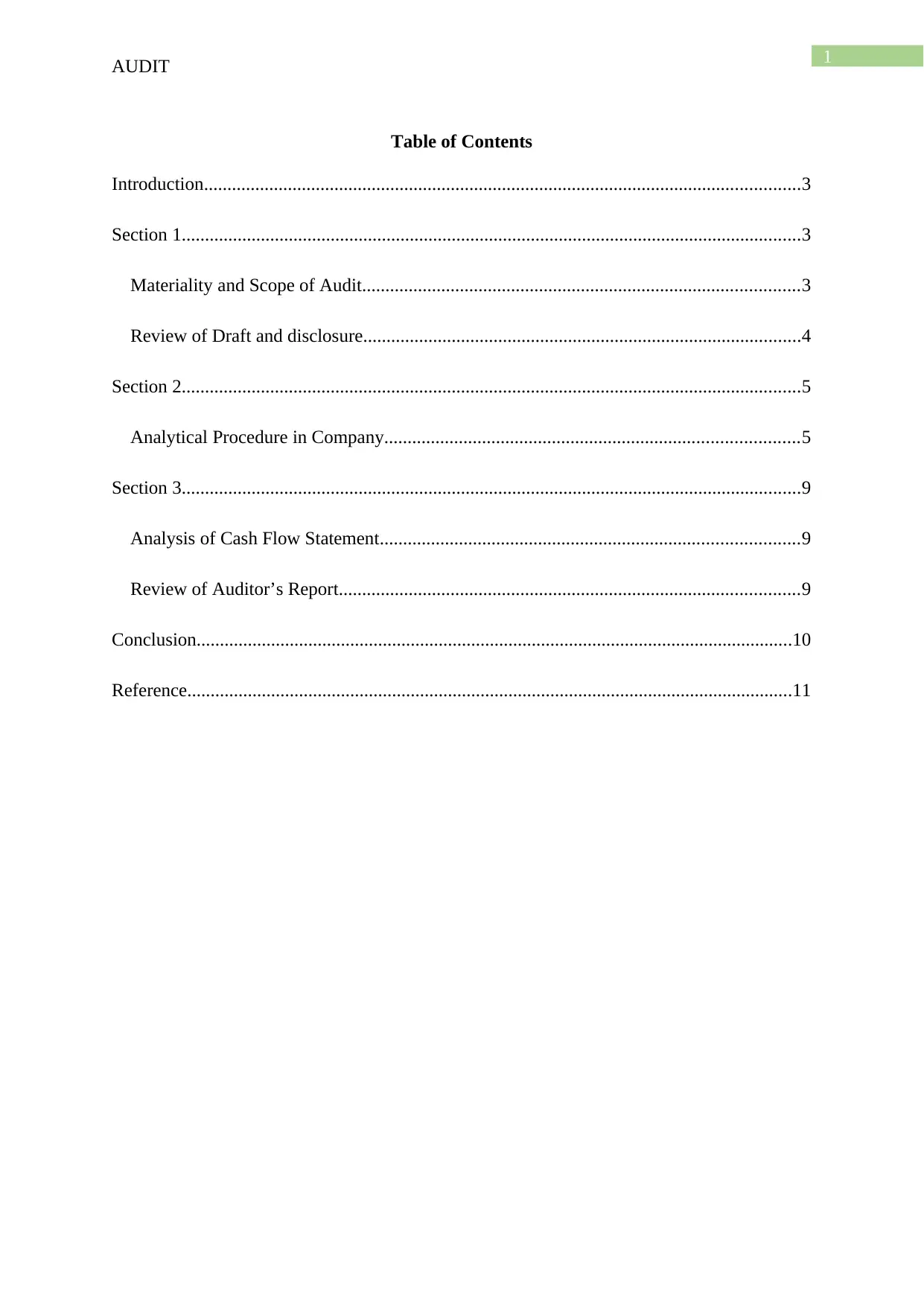
1
AUDIT
Table of Contents
Introduction................................................................................................................................3
Section 1.....................................................................................................................................3
Materiality and Scope of Audit..............................................................................................3
Review of Draft and disclosure..............................................................................................4
Section 2.....................................................................................................................................5
Analytical Procedure in Company.........................................................................................5
Section 3.....................................................................................................................................9
Analysis of Cash Flow Statement..........................................................................................9
Review of Auditor’s Report...................................................................................................9
Conclusion................................................................................................................................10
Reference..................................................................................................................................11
AUDIT
Table of Contents
Introduction................................................................................................................................3
Section 1.....................................................................................................................................3
Materiality and Scope of Audit..............................................................................................3
Review of Draft and disclosure..............................................................................................4
Section 2.....................................................................................................................................5
Analytical Procedure in Company.........................................................................................5
Section 3.....................................................................................................................................9
Analysis of Cash Flow Statement..........................................................................................9
Review of Auditor’s Report...................................................................................................9
Conclusion................................................................................................................................10
Reference..................................................................................................................................11

2
AUDIT
AUDIT
⊘ This is a preview!⊘
Do you want full access?
Subscribe today to unlock all pages.

Trusted by 1+ million students worldwide
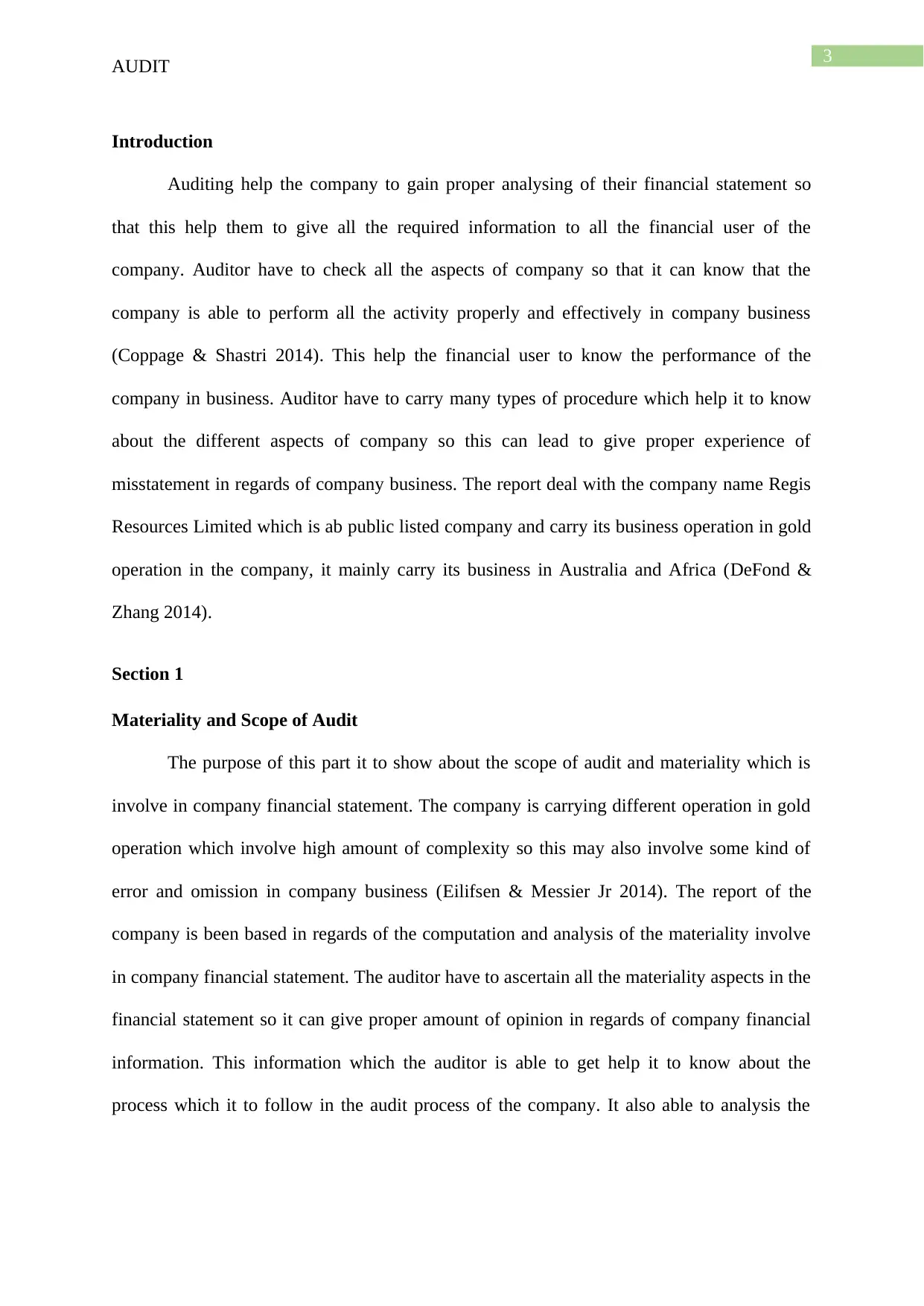
3
AUDIT
Introduction
Auditing help the company to gain proper analysing of their financial statement so
that this help them to give all the required information to all the financial user of the
company. Auditor have to check all the aspects of company so that it can know that the
company is able to perform all the activity properly and effectively in company business
(Coppage & Shastri 2014). This help the financial user to know the performance of the
company in business. Auditor have to carry many types of procedure which help it to know
about the different aspects of company so this can lead to give proper experience of
misstatement in regards of company business. The report deal with the company name Regis
Resources Limited which is ab public listed company and carry its business operation in gold
operation in the company, it mainly carry its business in Australia and Africa (DeFond &
Zhang 2014).
Section 1
Materiality and Scope of Audit
The purpose of this part it to show about the scope of audit and materiality which is
involve in company financial statement. The company is carrying different operation in gold
operation which involve high amount of complexity so this may also involve some kind of
error and omission in company business (Eilifsen & Messier Jr 2014). The report of the
company is been based in regards of the computation and analysis of the materiality involve
in company financial statement. The auditor have to ascertain all the materiality aspects in the
financial statement so it can give proper amount of opinion in regards of company financial
information. This information which the auditor is able to get help it to know about the
process which it to follow in the audit process of the company. It also able to analysis the
AUDIT
Introduction
Auditing help the company to gain proper analysing of their financial statement so
that this help them to give all the required information to all the financial user of the
company. Auditor have to check all the aspects of company so that it can know that the
company is able to perform all the activity properly and effectively in company business
(Coppage & Shastri 2014). This help the financial user to know the performance of the
company in business. Auditor have to carry many types of procedure which help it to know
about the different aspects of company so this can lead to give proper experience of
misstatement in regards of company business. The report deal with the company name Regis
Resources Limited which is ab public listed company and carry its business operation in gold
operation in the company, it mainly carry its business in Australia and Africa (DeFond &
Zhang 2014).
Section 1
Materiality and Scope of Audit
The purpose of this part it to show about the scope of audit and materiality which is
involve in company financial statement. The company is carrying different operation in gold
operation which involve high amount of complexity so this may also involve some kind of
error and omission in company business (Eilifsen & Messier Jr 2014). The report of the
company is been based in regards of the computation and analysis of the materiality involve
in company financial statement. The auditor have to ascertain all the materiality aspects in the
financial statement so it can give proper amount of opinion in regards of company financial
information. This information which the auditor is able to get help it to know about the
process which it to follow in the audit process of the company. It also able to analysis the
Paraphrase This Document
Need a fresh take? Get an instant paraphrase of this document with our AI Paraphraser

4
AUDIT
planning materiality so that the company is able to gain proper knowledge in regards of
financial statement, it should consider the same in company business (Elder et al., 2013).
Materiality concept is to taken very seriously so that the auditor able to know the risk
which is associated in the company financial statement. Company should able to give proper
assumption and estimation which they have taken in regards of its business operation.
Auditor should plan the materiality in the planning stage so that it can base the same to
assertion the amount of audit process which it to carry in the business operation. The auditor
have to plan the amount of, materiality which is involve in the same so that it can know how
much risk is associated in the business. It should take into consideration the sales, equity and
total asset while calculating the planning materiality in the business (Furnham & Gunter
2015). Planning Materiality shall be computed upon the highest figure in the business as it
should consider the total asset figure in company so that the auditor is able to know the
misstatement in the company. So the calculation of planning materiality is shown below:
Planning Materiality=Total Asset∗5 %
¿ $ 822530
¿ 5 %
¿ $ 41126.5
The above calculation show about the planning materiality in the company as it is
$41126.5 so this should be consider by the auditor in regards of company financial statement
so that the it can know the risk which is associated by the company and how the auditor is
able to carry different procedure in company business activities.
AUDIT
planning materiality so that the company is able to gain proper knowledge in regards of
financial statement, it should consider the same in company business (Elder et al., 2013).
Materiality concept is to taken very seriously so that the auditor able to know the risk
which is associated in the company financial statement. Company should able to give proper
assumption and estimation which they have taken in regards of its business operation.
Auditor should plan the materiality in the planning stage so that it can base the same to
assertion the amount of audit process which it to carry in the business operation. The auditor
have to plan the amount of, materiality which is involve in the same so that it can know how
much risk is associated in the business. It should take into consideration the sales, equity and
total asset while calculating the planning materiality in the business (Furnham & Gunter
2015). Planning Materiality shall be computed upon the highest figure in the business as it
should consider the total asset figure in company so that the auditor is able to know the
misstatement in the company. So the calculation of planning materiality is shown below:
Planning Materiality=Total Asset∗5 %
¿ $ 822530
¿ 5 %
¿ $ 41126.5
The above calculation show about the planning materiality in the company as it is
$41126.5 so this should be consider by the auditor in regards of company financial statement
so that the it can know the risk which is associated by the company and how the auditor is
able to carry different procedure in company business activities.
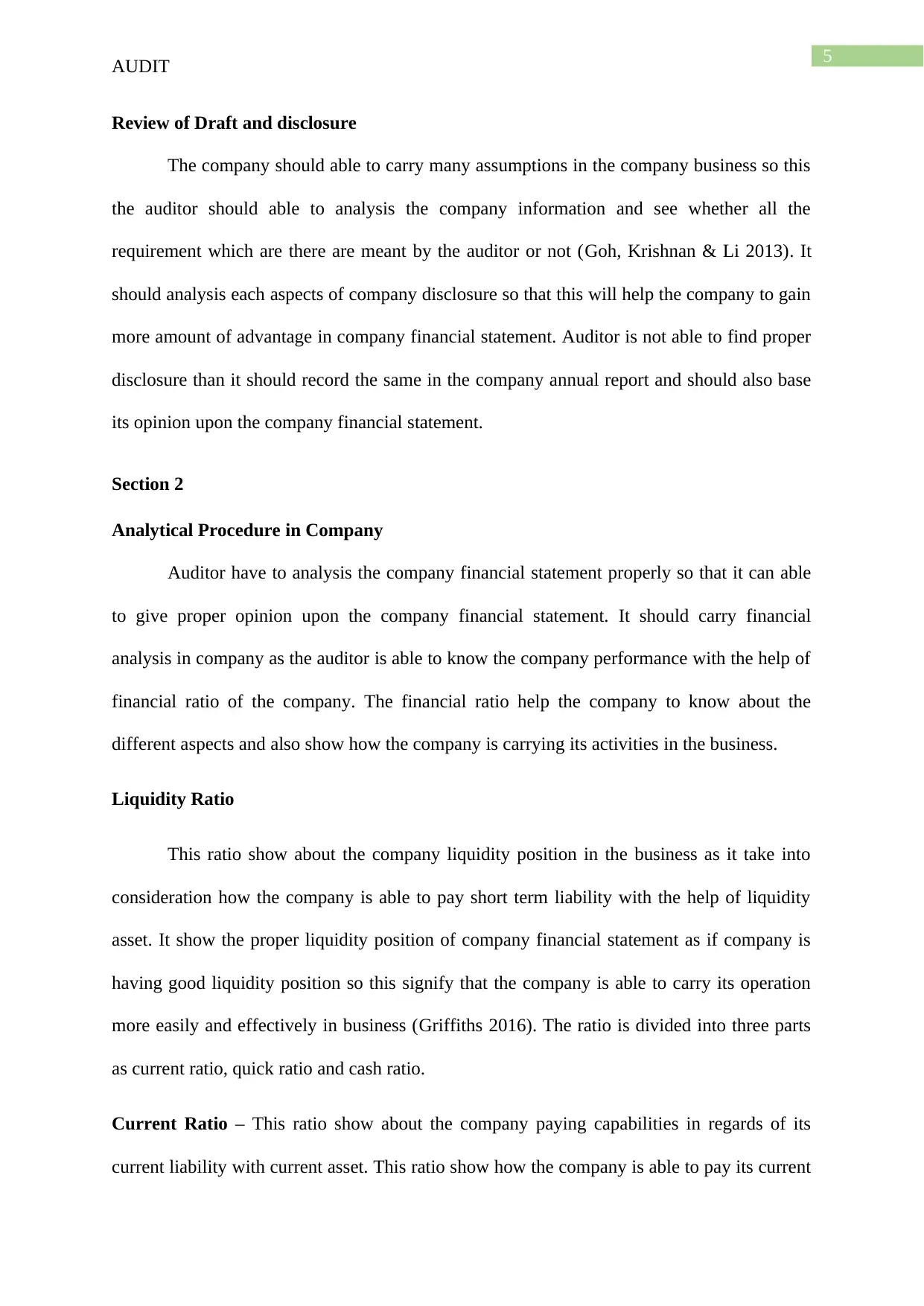
5
AUDIT
Review of Draft and disclosure
The company should able to carry many assumptions in the company business so this
the auditor should able to analysis the company information and see whether all the
requirement which are there are meant by the auditor or not (Goh, Krishnan & Li 2013). It
should analysis each aspects of company disclosure so that this will help the company to gain
more amount of advantage in company financial statement. Auditor is not able to find proper
disclosure than it should record the same in the company annual report and should also base
its opinion upon the company financial statement.
Section 2
Analytical Procedure in Company
Auditor have to analysis the company financial statement properly so that it can able
to give proper opinion upon the company financial statement. It should carry financial
analysis in company as the auditor is able to know the company performance with the help of
financial ratio of the company. The financial ratio help the company to know about the
different aspects and also show how the company is carrying its activities in the business.
Liquidity Ratio
This ratio show about the company liquidity position in the business as it take into
consideration how the company is able to pay short term liability with the help of liquidity
asset. It show the proper liquidity position of company financial statement as if company is
having good liquidity position so this signify that the company is able to carry its operation
more easily and effectively in business (Griffiths 2016). The ratio is divided into three parts
as current ratio, quick ratio and cash ratio.
Current Ratio – This ratio show about the company paying capabilities in regards of its
current liability with current asset. This ratio show how the company is able to pay its current
AUDIT
Review of Draft and disclosure
The company should able to carry many assumptions in the company business so this
the auditor should able to analysis the company information and see whether all the
requirement which are there are meant by the auditor or not (Goh, Krishnan & Li 2013). It
should analysis each aspects of company disclosure so that this will help the company to gain
more amount of advantage in company financial statement. Auditor is not able to find proper
disclosure than it should record the same in the company annual report and should also base
its opinion upon the company financial statement.
Section 2
Analytical Procedure in Company
Auditor have to analysis the company financial statement properly so that it can able
to give proper opinion upon the company financial statement. It should carry financial
analysis in company as the auditor is able to know the company performance with the help of
financial ratio of the company. The financial ratio help the company to know about the
different aspects and also show how the company is carrying its activities in the business.
Liquidity Ratio
This ratio show about the company liquidity position in the business as it take into
consideration how the company is able to pay short term liability with the help of liquidity
asset. It show the proper liquidity position of company financial statement as if company is
having good liquidity position so this signify that the company is able to carry its operation
more easily and effectively in business (Griffiths 2016). The ratio is divided into three parts
as current ratio, quick ratio and cash ratio.
Current Ratio – This ratio show about the company paying capabilities in regards of its
current liability with current asset. This ratio show how the company is able to pay its current
⊘ This is a preview!⊘
Do you want full access?
Subscribe today to unlock all pages.

Trusted by 1+ million students worldwide
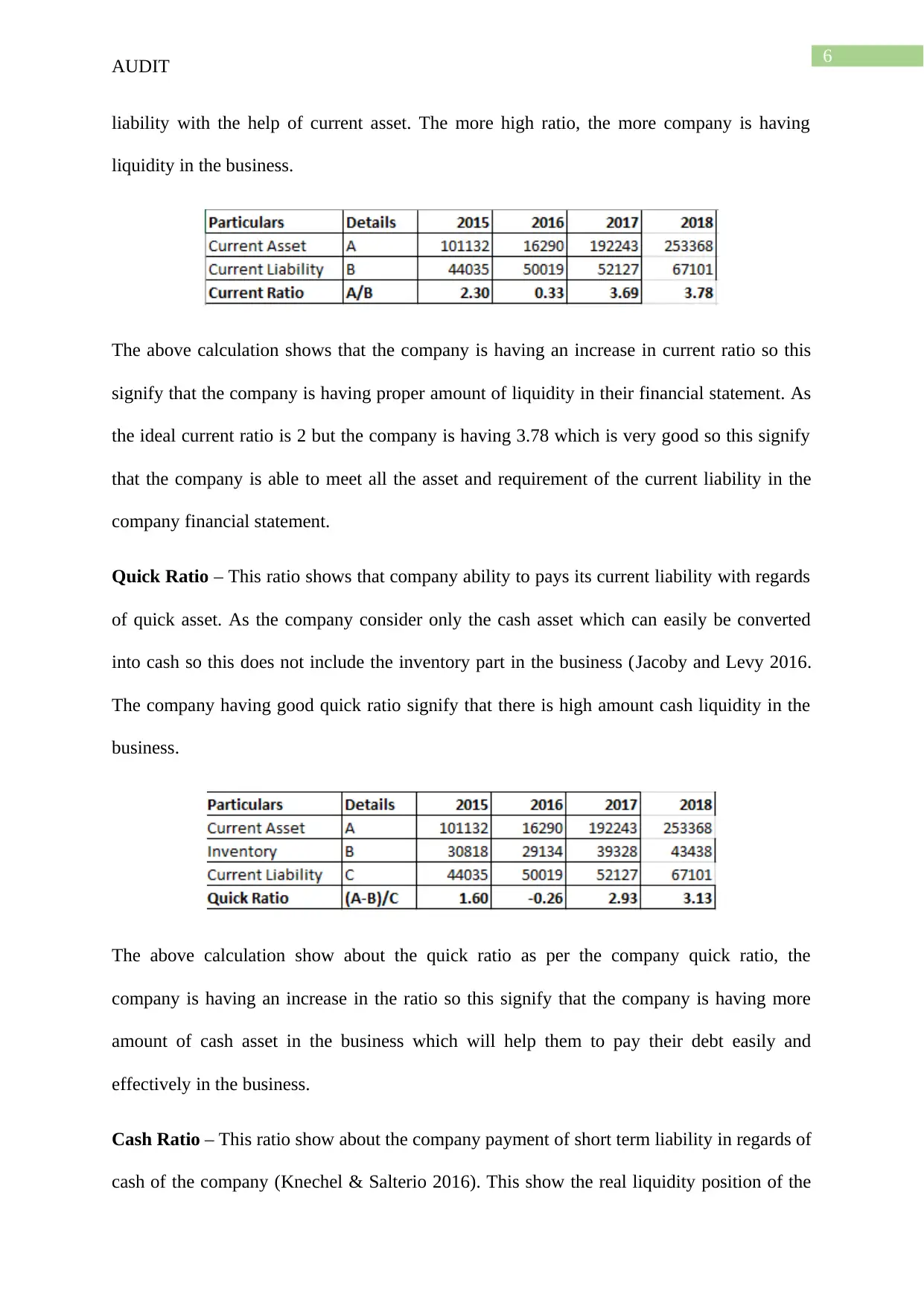
6
AUDIT
liability with the help of current asset. The more high ratio, the more company is having
liquidity in the business.
The above calculation shows that the company is having an increase in current ratio so this
signify that the company is having proper amount of liquidity in their financial statement. As
the ideal current ratio is 2 but the company is having 3.78 which is very good so this signify
that the company is able to meet all the asset and requirement of the current liability in the
company financial statement.
Quick Ratio – This ratio shows that company ability to pays its current liability with regards
of quick asset. As the company consider only the cash asset which can easily be converted
into cash so this does not include the inventory part in the business (Jacoby and Levy 2016.
The company having good quick ratio signify that there is high amount cash liquidity in the
business.
The above calculation show about the quick ratio as per the company quick ratio, the
company is having an increase in the ratio so this signify that the company is having more
amount of cash asset in the business which will help them to pay their debt easily and
effectively in the business.
Cash Ratio – This ratio show about the company payment of short term liability in regards of
cash of the company (Knechel & Salterio 2016). This show the real liquidity position of the
AUDIT
liability with the help of current asset. The more high ratio, the more company is having
liquidity in the business.
The above calculation shows that the company is having an increase in current ratio so this
signify that the company is having proper amount of liquidity in their financial statement. As
the ideal current ratio is 2 but the company is having 3.78 which is very good so this signify
that the company is able to meet all the asset and requirement of the current liability in the
company financial statement.
Quick Ratio – This ratio shows that company ability to pays its current liability with regards
of quick asset. As the company consider only the cash asset which can easily be converted
into cash so this does not include the inventory part in the business (Jacoby and Levy 2016.
The company having good quick ratio signify that there is high amount cash liquidity in the
business.
The above calculation show about the quick ratio as per the company quick ratio, the
company is having an increase in the ratio so this signify that the company is having more
amount of cash asset in the business which will help them to pay their debt easily and
effectively in the business.
Cash Ratio – This ratio show about the company payment of short term liability in regards of
cash of the company (Knechel & Salterio 2016). This show the real liquidity position of the
Paraphrase This Document
Need a fresh take? Get an instant paraphrase of this document with our AI Paraphraser
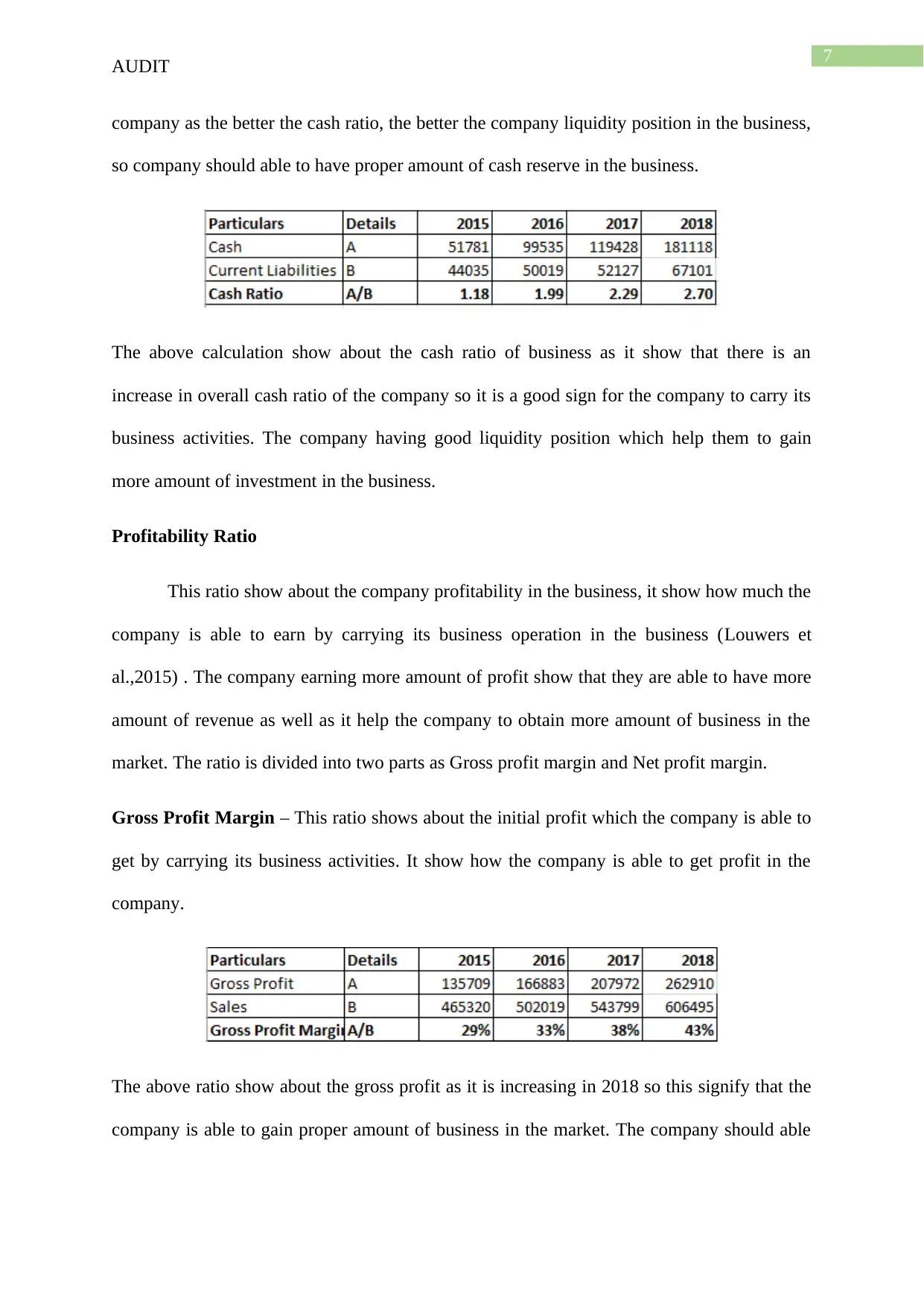
7
AUDIT
company as the better the cash ratio, the better the company liquidity position in the business,
so company should able to have proper amount of cash reserve in the business.
The above calculation show about the cash ratio of business as it show that there is an
increase in overall cash ratio of the company so it is a good sign for the company to carry its
business activities. The company having good liquidity position which help them to gain
more amount of investment in the business.
Profitability Ratio
This ratio show about the company profitability in the business, it show how much the
company is able to earn by carrying its business operation in the business (Louwers et
al.,2015) . The company earning more amount of profit show that they are able to have more
amount of revenue as well as it help the company to obtain more amount of business in the
market. The ratio is divided into two parts as Gross profit margin and Net profit margin.
Gross Profit Margin – This ratio shows about the initial profit which the company is able to
get by carrying its business activities. It show how the company is able to get profit in the
company.
The above ratio show about the gross profit as it is increasing in 2018 so this signify that the
company is able to gain proper amount of business in the market. The company should able
AUDIT
company as the better the cash ratio, the better the company liquidity position in the business,
so company should able to have proper amount of cash reserve in the business.
The above calculation show about the cash ratio of business as it show that there is an
increase in overall cash ratio of the company so it is a good sign for the company to carry its
business activities. The company having good liquidity position which help them to gain
more amount of investment in the business.
Profitability Ratio
This ratio show about the company profitability in the business, it show how much the
company is able to earn by carrying its business operation in the business (Louwers et
al.,2015) . The company earning more amount of profit show that they are able to have more
amount of revenue as well as it help the company to obtain more amount of business in the
market. The ratio is divided into two parts as Gross profit margin and Net profit margin.
Gross Profit Margin – This ratio shows about the initial profit which the company is able to
get by carrying its business activities. It show how the company is able to get profit in the
company.
The above ratio show about the gross profit as it is increasing in 2018 so this signify that the
company is able to gain proper amount of business in the market. The company should able
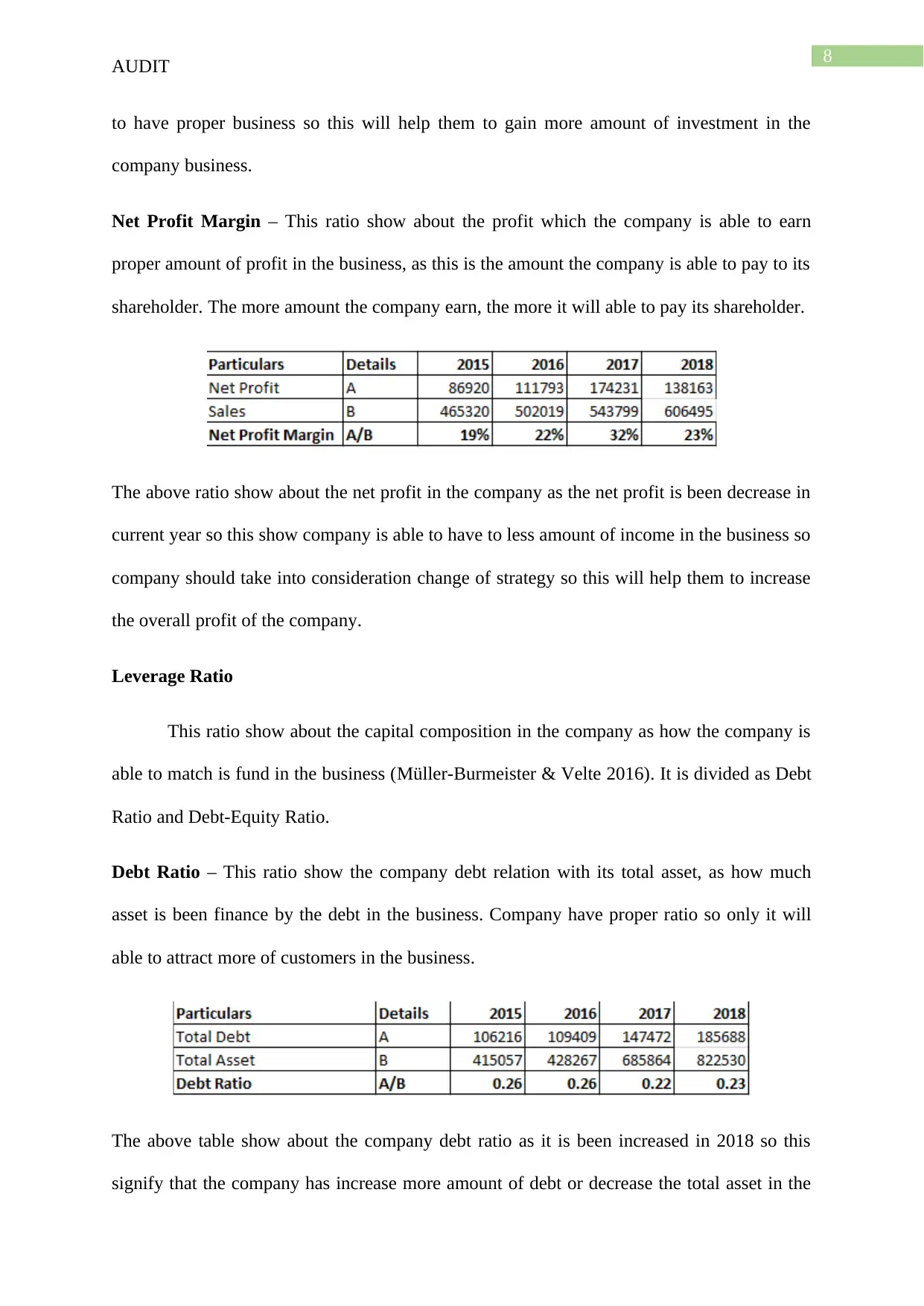
8
AUDIT
to have proper business so this will help them to gain more amount of investment in the
company business.
Net Profit Margin – This ratio show about the profit which the company is able to earn
proper amount of profit in the business, as this is the amount the company is able to pay to its
shareholder. The more amount the company earn, the more it will able to pay its shareholder.
The above ratio show about the net profit in the company as the net profit is been decrease in
current year so this show company is able to have to less amount of income in the business so
company should take into consideration change of strategy so this will help them to increase
the overall profit of the company.
Leverage Ratio
This ratio show about the capital composition in the company as how the company is
able to match is fund in the business (Müller-Burmeister & Velte 2016). It is divided as Debt
Ratio and Debt-Equity Ratio.
Debt Ratio – This ratio show the company debt relation with its total asset, as how much
asset is been finance by the debt in the business. Company have proper ratio so only it will
able to attract more of customers in the business.
The above table show about the company debt ratio as it is been increased in 2018 so this
signify that the company has increase more amount of debt or decrease the total asset in the
AUDIT
to have proper business so this will help them to gain more amount of investment in the
company business.
Net Profit Margin – This ratio show about the profit which the company is able to earn
proper amount of profit in the business, as this is the amount the company is able to pay to its
shareholder. The more amount the company earn, the more it will able to pay its shareholder.
The above ratio show about the net profit in the company as the net profit is been decrease in
current year so this show company is able to have to less amount of income in the business so
company should take into consideration change of strategy so this will help them to increase
the overall profit of the company.
Leverage Ratio
This ratio show about the capital composition in the company as how the company is
able to match is fund in the business (Müller-Burmeister & Velte 2016). It is divided as Debt
Ratio and Debt-Equity Ratio.
Debt Ratio – This ratio show the company debt relation with its total asset, as how much
asset is been finance by the debt in the business. Company have proper ratio so only it will
able to attract more of customers in the business.
The above table show about the company debt ratio as it is been increased in 2018 so this
signify that the company has increase more amount of debt or decrease the total asset in the
⊘ This is a preview!⊘
Do you want full access?
Subscribe today to unlock all pages.

Trusted by 1+ million students worldwide
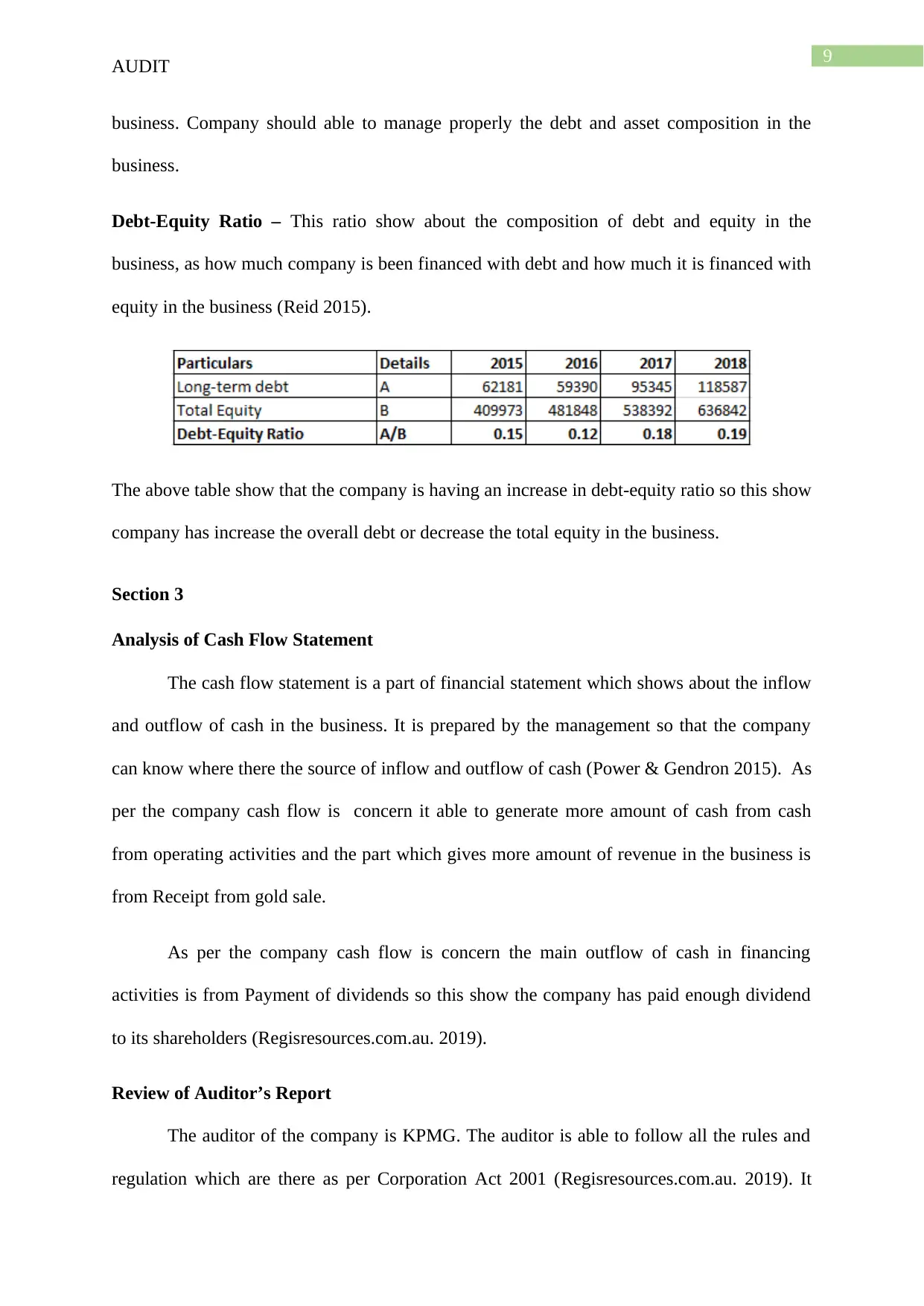
9
AUDIT
business. Company should able to manage properly the debt and asset composition in the
business.
Debt-Equity Ratio – This ratio show about the composition of debt and equity in the
business, as how much company is been financed with debt and how much it is financed with
equity in the business (Reid 2015).
The above table show that the company is having an increase in debt-equity ratio so this show
company has increase the overall debt or decrease the total equity in the business.
Section 3
Analysis of Cash Flow Statement
The cash flow statement is a part of financial statement which shows about the inflow
and outflow of cash in the business. It is prepared by the management so that the company
can know where there the source of inflow and outflow of cash (Power & Gendron 2015). As
per the company cash flow is concern it able to generate more amount of cash from cash
from operating activities and the part which gives more amount of revenue in the business is
from Receipt from gold sale.
As per the company cash flow is concern the main outflow of cash in financing
activities is from Payment of dividends so this show the company has paid enough dividend
to its shareholders (Regisresources.com.au. 2019).
Review of Auditor’s Report
The auditor of the company is KPMG. The auditor is able to follow all the rules and
regulation which are there as per Corporation Act 2001 (Regisresources.com.au. 2019). It
AUDIT
business. Company should able to manage properly the debt and asset composition in the
business.
Debt-Equity Ratio – This ratio show about the composition of debt and equity in the
business, as how much company is been financed with debt and how much it is financed with
equity in the business (Reid 2015).
The above table show that the company is having an increase in debt-equity ratio so this show
company has increase the overall debt or decrease the total equity in the business.
Section 3
Analysis of Cash Flow Statement
The cash flow statement is a part of financial statement which shows about the inflow
and outflow of cash in the business. It is prepared by the management so that the company
can know where there the source of inflow and outflow of cash (Power & Gendron 2015). As
per the company cash flow is concern it able to generate more amount of cash from cash
from operating activities and the part which gives more amount of revenue in the business is
from Receipt from gold sale.
As per the company cash flow is concern the main outflow of cash in financing
activities is from Payment of dividends so this show the company has paid enough dividend
to its shareholders (Regisresources.com.au. 2019).
Review of Auditor’s Report
The auditor of the company is KPMG. The auditor is able to follow all the rules and
regulation which are there as per Corporation Act 2001 (Regisresources.com.au. 2019). It
Paraphrase This Document
Need a fresh take? Get an instant paraphrase of this document with our AI Paraphraser
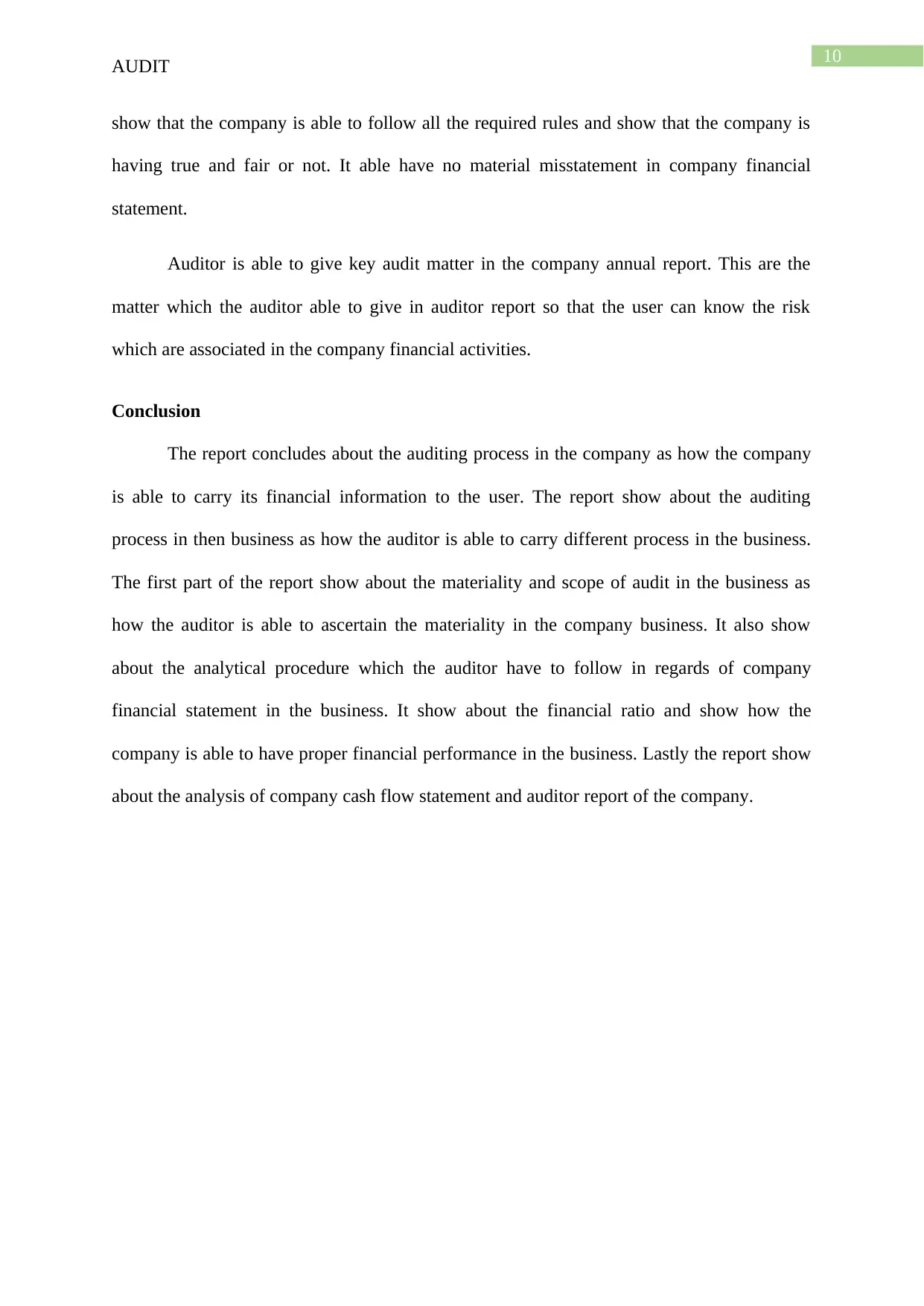
10
AUDIT
show that the company is able to follow all the required rules and show that the company is
having true and fair or not. It able have no material misstatement in company financial
statement.
Auditor is able to give key audit matter in the company annual report. This are the
matter which the auditor able to give in auditor report so that the user can know the risk
which are associated in the company financial activities.
Conclusion
The report concludes about the auditing process in the company as how the company
is able to carry its financial information to the user. The report show about the auditing
process in then business as how the auditor is able to carry different process in the business.
The first part of the report show about the materiality and scope of audit in the business as
how the auditor is able to ascertain the materiality in the company business. It also show
about the analytical procedure which the auditor have to follow in regards of company
financial statement in the business. It show about the financial ratio and show how the
company is able to have proper financial performance in the business. Lastly the report show
about the analysis of company cash flow statement and auditor report of the company.
AUDIT
show that the company is able to follow all the required rules and show that the company is
having true and fair or not. It able have no material misstatement in company financial
statement.
Auditor is able to give key audit matter in the company annual report. This are the
matter which the auditor able to give in auditor report so that the user can know the risk
which are associated in the company financial activities.
Conclusion
The report concludes about the auditing process in the company as how the company
is able to carry its financial information to the user. The report show about the auditing
process in then business as how the auditor is able to carry different process in the business.
The first part of the report show about the materiality and scope of audit in the business as
how the auditor is able to ascertain the materiality in the company business. It also show
about the analytical procedure which the auditor have to follow in regards of company
financial statement in the business. It show about the financial ratio and show how the
company is able to have proper financial performance in the business. Lastly the report show
about the analysis of company cash flow statement and auditor report of the company.
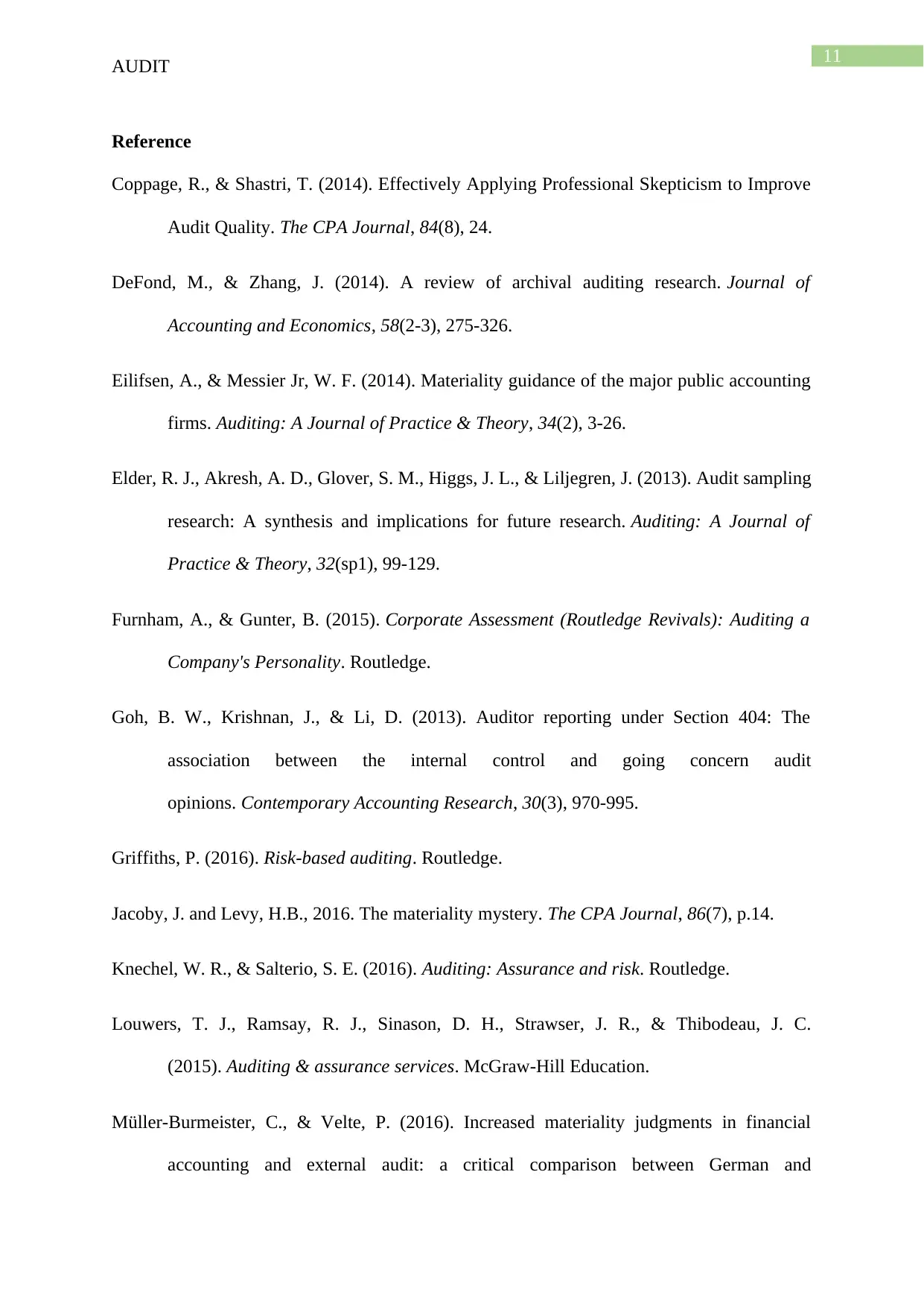
11
AUDIT
Reference
Coppage, R., & Shastri, T. (2014). Effectively Applying Professional Skepticism to Improve
Audit Quality. The CPA Journal, 84(8), 24.
DeFond, M., & Zhang, J. (2014). A review of archival auditing research. Journal of
Accounting and Economics, 58(2-3), 275-326.
Eilifsen, A., & Messier Jr, W. F. (2014). Materiality guidance of the major public accounting
firms. Auditing: A Journal of Practice & Theory, 34(2), 3-26.
Elder, R. J., Akresh, A. D., Glover, S. M., Higgs, J. L., & Liljegren, J. (2013). Audit sampling
research: A synthesis and implications for future research. Auditing: A Journal of
Practice & Theory, 32(sp1), 99-129.
Furnham, A., & Gunter, B. (2015). Corporate Assessment (Routledge Revivals): Auditing a
Company's Personality. Routledge.
Goh, B. W., Krishnan, J., & Li, D. (2013). Auditor reporting under Section 404: The
association between the internal control and going concern audit
opinions. Contemporary Accounting Research, 30(3), 970-995.
Griffiths, P. (2016). Risk-based auditing. Routledge.
Jacoby, J. and Levy, H.B., 2016. The materiality mystery. The CPA Journal, 86(7), p.14.
Knechel, W. R., & Salterio, S. E. (2016). Auditing: Assurance and risk. Routledge.
Louwers, T. J., Ramsay, R. J., Sinason, D. H., Strawser, J. R., & Thibodeau, J. C.
(2015). Auditing & assurance services. McGraw-Hill Education.
Müller-Burmeister, C., & Velte, P. (2016). Increased materiality judgments in financial
accounting and external audit: a critical comparison between German and
AUDIT
Reference
Coppage, R., & Shastri, T. (2014). Effectively Applying Professional Skepticism to Improve
Audit Quality. The CPA Journal, 84(8), 24.
DeFond, M., & Zhang, J. (2014). A review of archival auditing research. Journal of
Accounting and Economics, 58(2-3), 275-326.
Eilifsen, A., & Messier Jr, W. F. (2014). Materiality guidance of the major public accounting
firms. Auditing: A Journal of Practice & Theory, 34(2), 3-26.
Elder, R. J., Akresh, A. D., Glover, S. M., Higgs, J. L., & Liljegren, J. (2013). Audit sampling
research: A synthesis and implications for future research. Auditing: A Journal of
Practice & Theory, 32(sp1), 99-129.
Furnham, A., & Gunter, B. (2015). Corporate Assessment (Routledge Revivals): Auditing a
Company's Personality. Routledge.
Goh, B. W., Krishnan, J., & Li, D. (2013). Auditor reporting under Section 404: The
association between the internal control and going concern audit
opinions. Contemporary Accounting Research, 30(3), 970-995.
Griffiths, P. (2016). Risk-based auditing. Routledge.
Jacoby, J. and Levy, H.B., 2016. The materiality mystery. The CPA Journal, 86(7), p.14.
Knechel, W. R., & Salterio, S. E. (2016). Auditing: Assurance and risk. Routledge.
Louwers, T. J., Ramsay, R. J., Sinason, D. H., Strawser, J. R., & Thibodeau, J. C.
(2015). Auditing & assurance services. McGraw-Hill Education.
Müller-Burmeister, C., & Velte, P. (2016). Increased materiality judgments in financial
accounting and external audit: a critical comparison between German and
⊘ This is a preview!⊘
Do you want full access?
Subscribe today to unlock all pages.

Trusted by 1+ million students worldwide
1 out of 13
Related Documents
Your All-in-One AI-Powered Toolkit for Academic Success.
+13062052269
info@desklib.com
Available 24*7 on WhatsApp / Email
![[object Object]](/_next/static/media/star-bottom.7253800d.svg)
Unlock your academic potential
Copyright © 2020–2025 A2Z Services. All Rights Reserved. Developed and managed by ZUCOL.





